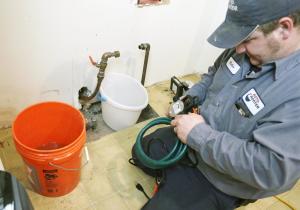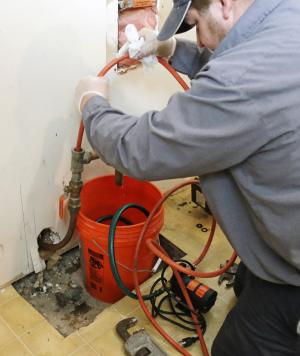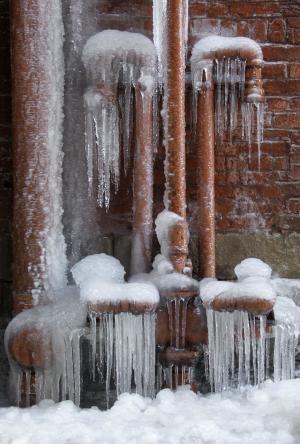Imagine were we all to finish the headline what would Today be? For some of us, it's to early to tell. But for others we are somewhere between dread and excitement. Most of us probably fall somewhere in the middle. And still others, a little bit of both.
I'm not sure I want to take on the dread part and there's plenty of it to go around. Going through a routine day with little of much happening seems to be the other end of the spectrum. There are three types of people in the world, those that make things happen, those who things happen too and the last group, who, with hands in the air, say "What Happened?"
I am told there is only one variable that we control in a day and that is how we respond to what happens on this day. Easier said then done. Tragedy can turn a day around real quick, but so can a wedding or the birth of a child. I am going to feel sad about the one and joy about the other. My response MAY be predicated on how feel about the event both good and bad. Smart alec types LOVE to tell you that you are responsible for your actions.
Wednesday, February 19, 2014
Obamacare's Latest Surprise for Taxpayers?

Good news for insurers, bad news for taxpayers.
Industry sources tell the Washington Examiner’s Susan Ferrechio
that the Barack Obama administration is thinking of extending the
Affordable Care Act's "risk corridors," the federal reimbursement
program for health-insurance companies that lose money by participating
in the newly created health-care exchanges. This is not the first time
we’ve seen this idea floated, and frankly, believing that the
administration is considering it is all too easy.
If you’re not familiar with the risk-corridor program, read what I’ve written in the past. Basically, there are three temporary risk-adjustment programs to help insurers transition into the new marketplaces. One of them -- a sort of reinsurance program, called the risk corridors, that offsets losses when claims are greater than 103 percent of projections and collects money from insurers whose claims are less than 97 percent of what they expected -- is not designed to be revenue-neutral. That means that if the insurance pool is a lot sicker than initially expected, the federal government could end up transferring a bunch of money to the insurance industry.
Because a lot of insurers seem to be saying that they’re going to lose money on their exchange policies this year, that’s a little worrying for the U.S. taxpayer.
But not that worrying, because the corridors are supposed to expire in three years. If it’s true that the administration is seriously considering extending them, that raises some disturbing possibilities:
Of course, the administration has gotten creative before, so don’t count it out. But if it does extend the program, it is basically confessing two things: It thinks the law is whatever it says it is, and it never really cared how much the program cost.
To contact the writer of this article:
Megan McArdle at mmcardle3@bloomberg.net.
To contact the editor responsible for this article:
James Gibney at +1-202-624-1863 or jgibney5@bloomberg.net.
If you’re not familiar with the risk-corridor program, read what I’ve written in the past. Basically, there are three temporary risk-adjustment programs to help insurers transition into the new marketplaces. One of them -- a sort of reinsurance program, called the risk corridors, that offsets losses when claims are greater than 103 percent of projections and collects money from insurers whose claims are less than 97 percent of what they expected -- is not designed to be revenue-neutral. That means that if the insurance pool is a lot sicker than initially expected, the federal government could end up transferring a bunch of money to the insurance industry.
Because a lot of insurers seem to be saying that they’re going to lose money on their exchange policies this year, that’s a little worrying for the U.S. taxpayer.
But not that worrying, because the corridors are supposed to expire in three years. If it’s true that the administration is seriously considering extending them, that raises some disturbing possibilities:
- Most obviously, the administration (and insurers) believes the
market for individual exchange policies is likely to be still having
serious problems in 2017.
- The insurers have clearly been willing to lose money on these
policies for a couple of years in order to help the exchanges get
established. But with the rollout difficulties and the somewhat
underwhelming enrollment numbers, they may be threatening to bolt unless
they get some guarantee that they can sell policies people will
actually be willing to buy.
- A risk-corridor extension would help keep the price of
policies down by funneling a backdoor subsidy to the insurers. However,
it would not keep the cost down -- indeed, it could have the opposite
effect. With the administration subsidizing the lion’s share of any
losses, the incentives to control costs would be dramatically weakened.
- With health-care cost growth already running well above
inflation in most years, this could be quite expensive. Basically, the
administration would be violating all the promises that were made about
deficit reduction and cost control in a desperate bid to keep insurers
on the exchanges.
Of course, the administration has gotten creative before, so don’t count it out. But if it does extend the program, it is basically confessing two things: It thinks the law is whatever it says it is, and it never really cared how much the program cost.
To contact the writer of this article:
Megan McArdle at mmcardle3@bloomberg.net.
To contact the editor responsible for this article:
James Gibney at +1-202-624-1863 or jgibney5@bloomberg.net.
Bloomberg reserves the right to edit or remove comments but is under
no obligation to do so, or to explain individual moderation decisions.
Legal Cash-Only Pot Sellers Supermarkets for Crooks
They come in the middle of the night. Breaking through doors, heads and
faces covered to hide from surveillance cameras. Sometimes, they bring
guns.
Amid Colorado's booming legal recreational and medical marijuana trade,
thieves are busting into shops and grow facilities looking for cash,
sometimes running out with pot plants worth thousands of dollars.
Kristi Kelly, owner of GoodMeds Marijuana Dispensary, was hit three
times by burglars taking advantage of an industry that is drowning in
cash.
In Denver alone, there have been 17 reported burglaries at marijuana
grows, dispensaries or manufacturers since January first, according to
numbers compiled by the Denver Police Department.
Part of what makes Kelly and thousands of legal marijuana business
owners vulnerable is that they operate largely as cash-only companies,
without the ability to open a bank account.
Kelly must pay her employees in cash that often smells like pot. She
cannot use checks to pay taxes, or accept credit cards from customers.
Banks keep shutting Kelly down because the US government still considers
marijuana illegal, and banks must answer to federal regulators."In the last 18 months, I've lost six bank accounts," she told ABC News. "I feel very paranoid. I feel I'm always looking over my shoulder even if I have nothing of value on me."
Another company that wanted to remain anonymous showed ABC News how it paid taxes of $200,000 in cash.
Kelly recently turned her shop into a virtual fortress, complete with nine visible cameras - the others are hidden.
"I have complete control over who comes in and out," she said.Kelly said she made an effort to not keep large amounts of cash in one place. Moving the money around is a potentially dangerous prospect.
"Our security protocols change on a weekly basis," Kelly said. "So if someone were to watch our patterns we wouldn't have any patterns because every week we're changing them. The times of day, the places, the locations, everything about the transfer of any of our valuable assets is taken into consideration."
Other marijuana companies have also turned to heavily armed private security for help.
Ted Daniels, president of Blue Line Protection Group, took ABC News on one of 1,000 runs his guards make every month. He hires former military and law enforcement people as guards.
Leonid Pavlushkin used to be a sniper in the Russian Special Forces and
spent time as n the NYPD. Before heading out on a job for Blue Line, he
strapped a Glock handgun to his thigh and loaded an M-4 assault rife,
just in case.
On a recent trip to deliver marijuana to a medical dispensary,
Pavlushkin drove while Daniels kept a close eye on their surroundings.
"We look for anything suspicious," Daniels told ABC News. "We look for any cars parked, any people sitting and watching.""We do move around large amounts of cash," Daniels said. "We don't like to say how much our clients have in their store."
As Pavlushkin stood watch outside, armed escorts brought new supplies of
weed in. Then, they unlocked the safe and removed the money, speeding
off minutes later to a secure, secret vault.
Although the Justice Department recently issued new guidelines
meant to reassure banks that they would not be prosecuted for doing
business with the pot industry, banks ABC News spoke with were not
convinced."[The guidance] only reinforces and reiterates that banks can be prosecuted for providing accounts to marijuana related businesses," said Don Childears, CEO of the Colorado Bankers Association.
"Bankers had expected the guidance to relieve them of the threat of
prosecution should the open accounts for marijuana businesses, but the
guidance does not do that. Instead, it reiterates reasons for
prosecution and is simply a modified reporting system for banks to use.
It imposes a heavy burden on them to know and control their customers'
activities, and those of their customers. No bank can comply," Childears
said in a statement.
The marijuana industry said that real safety would only come when Congress changed banking laws.
A bill being considered in the House of Representatives would prohibit
federal regulators from punishing banks who open accounts for legal
marijuana businesses.
"We want to be able to put out cash in a bank account and have a piece
of paper be good for that cash that we give to our employees or pay our
taxes," said Michael Elliot, executive director of the Medical Marijuana
Industry Group. "That very basic thing seems to be impossible to
A common winter hazard: frozen pipes in your home
Winter storm-related insurance losses "will be more this year due to the extreme cold and the breadth of the territory that is being affected by it," said Peter Foley, vice president of claims for the American Insurance Association. Those losses, which include damage from frozen pipes, total about $1.4 billion a year on average, according to the Insurance Information Institute.
People unaccustomed to extreme, prolonged cold, especially those in the South, are particularly vulnerable, said Robert Hartwig, the institute's president.
"There's a lack of
awareness of the fact that a pipe could freeze and what to do about it,"
he said. For instance, they may not shut off the water to outside
faucets, and their homes may have less insulation.
Damage from a burst pipe can vary greatly, depending on how long the water runs unabated.
Some tips on how to protect against frozen pipes, and what to do if one does freeze:BEFORE THE FREEZE
View gallery

FILE - In this Jan. 9, 2014 file photo, plumber Nate Petersen prepares a pump to shoot water into th …
You might leave the water dripping a little bit, advised Ken Collier, editor-in-chief of The Family Handyman.
"That just keeps enough water moving in the pipe so it's less likely to freeze," he said. "If there is some freezing, there is some give in the system because the faucet is open a little bit."
Collier
also suggested getting warmer, room-temperature air to where the pipes
are. That can be as simple as opening the cabinets under the kitchen
sink, especially if the sink is on an exterior wall. "In some cases, a
fan can help with that," he said.
Similarly, if pipes run through a crawl space, using a fan to blow in warmer air from the house's interior might help, he said.
Better
insulation is the ultimate fix, Collier said, but getting to the pipes
can be tricky because it often means breaking through walls.
WHEN A PIPE FREEZES
View gallery

FILE - In this Jan. 9, 2014 file photo, Roto Rooter plumber Nate Petersen pumps water into the incom …
Do frozen pipes always burst? "You can get lucky," Collier said.
"Once it's frozen, the damage is done," he said. "Some kinds of pipes break easier than others when the water inside freezes."Copper pipes are said to be more vulnerable.
It may seem obvious, but there are two clear ways to know if a pipe has frozen.
"A sign of a frozen pipe is you have no water," Foley said.
The other sign: flooding. That can happen when the burst pipe starts to thaw out and the water begins flowing again.
If the break is in an exposed piece of pipe, it may mean a flooded basement floor. If it's in a piece that's not exposed, the water could seep through a wall.
It's critical that homeowners know how to shut off the water to the entire house; that's "usually the only way to get the water pressure off the frozen place," Collier said.
Yes, it can be an inconvenience — you can't take a shower or wash the dishes. You can only flush the toilets once. But it's the best way to prevent further damage, he said.
WHAT NEXT?
Call a plumber, unless you have the skills and confidence to do the repair yourself.
A temporary fix might involve cutting away the damaged piece of pipe and replacing it with a rubber hose and clamps until the plumber gets there. The degree of difficulty could depend on how accessible the pipe is.
There also are various tapes and putties that might temporarily close the break.
And call your insurance agent. Homeowners policies generally cover damage related to pipes that freeze and burst.
"The
repair of the pipe might be a few hundred dollars," Hartwig said. "The
real issue comes in if the leak damages ceilings, floors, furniture,
carpeting, electrical work that might be in the wall."
The average claim is about $5,000, according to Foley.
View Comments (264)
Loneliness Is More Dangerous Than We Thought
 Photo: Getty ImagesFeeling like you might die of loneliness is one thing. But could it actually happen? Apparently, as researchers have found
that leading an extremely lonely existence could increase an older
person's chance of premature death by 14 percent — providing good reason
for everyone to make sure to maintain connections with others as they
age.
Photo: Getty ImagesFeeling like you might die of loneliness is one thing. But could it actually happen? Apparently, as researchers have found
that leading an extremely lonely existence could increase an older
person's chance of premature death by 14 percent — providing good reason
for everyone to make sure to maintain connections with others as they
age.More on Shine: Why Widows Deal With Chronic Pain Better Than Married Folks
“We looked at perceived loneliness versus objective isolation, and how it leads the brain’s biology to change over time,” John Cacioppo, University of Chicago psychology professor and the study's lead researcher, tells Yahoo Shine. “There are toxic effects.” Even after taking into account lifestyle behaviors, like diet and exercise, he adds, the impact of simply feeling isolated — disrupted sleep, elevated blood pressure, surges in the stress hormone cortisol, compromised immunity, and increased depression overall — is profound. “When you are isolated from companionship, then the brain goes into self-preservation mode,” Cacioppo notes.
For his findings — shared Feb. 16 at a scholarly seminar on aging at the American Association for the Advancement of Science annual meeting in Chicago — Cacioppo, one of the nation’s leading experts on loneliness, examined data from a 2010 meta-analysis.
More on Yahoo: Don't Neglect Oral Healthcare in Frail, Elderly: Study
For seniors, loneliness can be particularly threatening. “This study makes sense to me,” Paul Kirwin, an associate professor of psychiatry at Yale University and past president of the American Association for Geriatric Psychiatry, tells Yahoo Shine. “There are so many losses that happen in this stage of life — of partners, friends, the loss of one’s role or sense of purpose — and it has a huge impact on people psychologically.”
Previous studies on loneliness have found that it can have myriad impacts on people’s health. In 2012, for example, University of San Francisco geriatrician Carla Perissinotto found that 24.8 percent of seniors who felt lonely reported declines in their ability to perform daily-life activities — bathing, dressing, eating, or getting up from a chair on their own; among those not feeling lonely, only 12.5 percent reported such declines.
“Lonely older adults also were 45 percent more likely to die [earlier] than seniors who felt meaningfully connected with others, even after results were adjusted for factors like depression, socioeconomic status and existing health conditions,” the New York Times noted about Perssinotto’s study. But that research, Cacioppo suggests, did not strip out the added effects of lifestyle choices (diet, exercise, etc.) as his new study did.
He stresses that loneliness is an equal-opportunity emotion and can strike people whether or not they are in a relationship. “You can feel connected when not with someone, so loneliness is not a solitary experience,” he says. He also suggests staving off feelings of isolation before they start, especially for older adults.
“Retiring to Florida to live in a warmer climate among strangers isn’t necessarily a good idea if it means you are disconnected from the people who mean the most to you,” Cacioppo noted in a press release about the findings. “We are experiencing a silver tsunami demographically. The baby boomers are reaching retirement age. Each day between 2011 and 2030, an average of 10,000 people will turn 65,” he added. “People have to think about how to protect themselves from depression, low subjective well-being and early mortality.”
Psychologist Guy Winch, based in New York, dedicates a chapter of his book “Emotional First Aid” to loneliness. To fight it, he tells Yahoo Shine, “realize that there are more opportunities to connect than you might realize.” This, he notes, requires a “leap of faith,” and should be viewed as a process of connecting gradually. Therapy, he adds, can help lonely people to identify what he calls “self-defeating patterns” that might be getting in the way of making meaningful connections.
“Loneliness is defined as a subjective experience, and as social or emotional isolation or both,” he notes. “And what it does, psychologically speaking, is to make us feel so emotionally raw and averse to rejection that it changes how people respond socially — often pushing away the people who can alleviate their loneliness.”
More on Yahoo Shine:
Depression: A Warning Sign of Stroke for Women
Is Kim Kardashian's Pregnancy Lonely? (No, She's Fine)
<SCRIPT
language='JavaScript1.1'
SRC="https://ad.doubleclick.net/adj/N5767.YAHOO/B7975171.7;abr=!ie;sz=300x250;pc=YHO3LI61FR;dcopt=rcl;mtfIFPath=nofile;click=http://clicks.beap.bc.yahoo.com/yc/YnY9MS4wLjAmYnM9KDE3NzZkNzdocChnaWQkME1FUy5qSXdOaTVqQVM5YVVaWm9UUUZ0T1RndU1sTUVtNlBfb0hMWSxzdCQxMzkyODEwOTE1Nzg0MTQwLHNpJDQ0NTcwNTEsc3AkOTY3MTQzMDEzLGNyJDM5NDQ5NDEwNTEsdiQyLjAsYWlkJHZOa2l0bUtMYzJVLSxjdCQyNSx5YngkNm1zbkFKRy5pcm9QOTlGM1A0dWNkQSxiaSQyMDU3ODU3MDUxLG1tZSQ4NjY1NjA1NjkyNzUzNTA3MTcxLHIkMSx5b28kMSxhZ3AkMzEyNzA0NjU1MSxhcCRMUkVDKSk/1/*;ord=1392810915.838247?"></SCRIPT><NOSCRIPT><A
HREF="http://clicks.beap.bc.yahoo.com/yc/YnY9MS4wLjAmYnM9KDE3a280dGUyYihnaWQkME1FUy5qSXdOaTVqQVM5YVVaWm9UUUZ0T1RndU1sTUVtNlBfb0hMWSxzdCQxMzkyODEwOTE1Nzg0MTQwLHNpJDQ0NTcwNTEsc3AkOTY3MTQzMDEzLGNyJDM5NDQ5NDEwNTEsdiQyLjAsYWlkJHZOa2l0bUtMYzJVLSxjdCQyNSx5YngkNm1zbkFKRy5pcm9QOTlGM1A0dWNkQSxiaSQyMDU3ODU3MDUxLG1tZSQ4NjY1NjA1NjkyNzUzNTA3MTcxLHIkMixyZCQxM280OGwzcGoseW9vJDEsYWdwJDMxMjcwNDY1NTEsYXAkTFJFQykp/0/*https://ad.doubleclick.net/jump/N5767.YAHOO/B7975171.7;abr=!ie4;abr=!ie5;sz=300x250;pc=YHO3LI61FR;ord=1392810915.838247?"><IMG
SRC="https://ad.doubleclick.net/ad/N5767.YAHOO/B7975171.7;abr=!ie4;abr=!ie5;sz=300x250;pc=YHO3LI61FR;ord=1392810915.838247?"
BORDER=0 WIDTH=300 HEIGHT=250
ALT="Advertisement"></A></NOSCRIPT>
Follow Shine
Join us on Pinterest
More on Yahoo
- Loneliness Is More Dangerous Than We … Healthy Living - 15 hours ago
- Kate Middleton Takes on New Role as … Parenting - 19 hours ago
- Top 3 Food Ingredients that Hurt Your … Healthy Living - 19 hours ago
- Dog with Mysterious Photo Gets a Ho … Pets - 19 hours ago
- 7 Dog Myths that Lead to Mishaps Pets - 21 hours ago
Subscribe to:
Posts (Atom)



